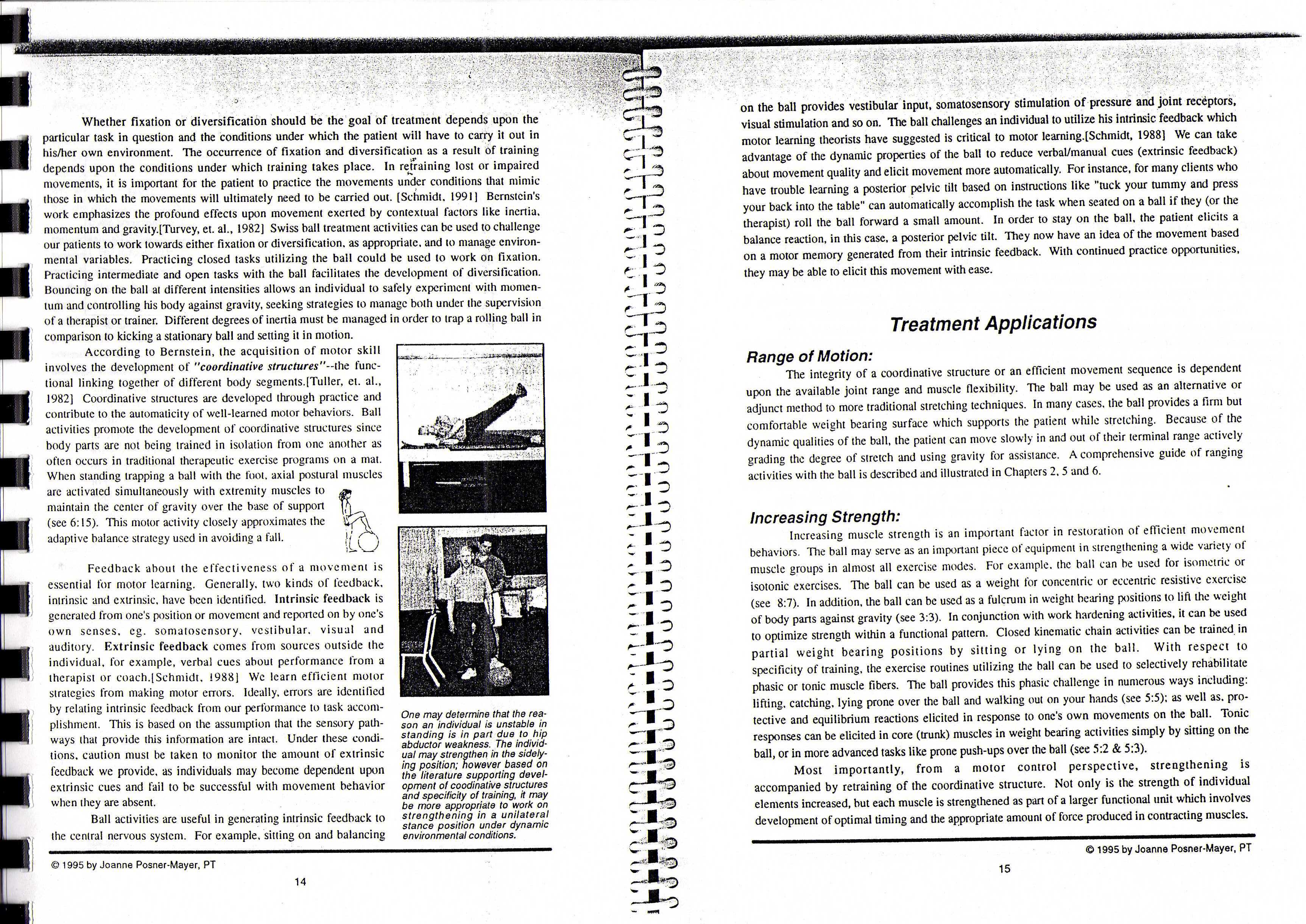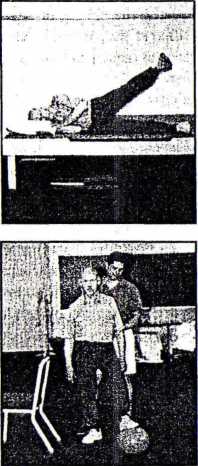img021



One may determine that the rea-son an individual is unstable in standing is in part due to hip abductor weakness. The individ-ual may strengthen in the sideiy-ing position; howeyer based on the literaturę supporting devel-opment ol coodinative structures and specificity of training, it may be morę appropriate to work on strengthening in a unilateral stance position under dynamie enyironmental conditions.
Pk
iO
Whether fixation or diversificalion should be the goal of trcatmcnt dcpends upon ihe particular task in question and the conditions under which the patient will have to carry it out in his/hcr own environment. The occurrence of fixation and diversifica(ion as a result of training depends upon the conditions under which training takes place. In retraining lost or impaired niovements, it is importanl for the patient to practice the movements under conditions that mimie those in which the movements will ultimately need to be carried out. [Schmidt. 1991] Bernslcin's work emphasizes the profound effects upon movement excrted by contextual factors like inertia. niomentum and gravity.[Turvey, et. al., 1982] Swiss bali treatment activities can be used to challenge our patients to work towards either fixation ordiversification. as appropriate, and to ntanage environ-mental variables. Practicing closed tasks utilizing the bali could be used to work on fixation. Practicing intermediate and open tasks with the bali facililales the developmenl of diversification. Bouncing on the bali al different intensities allows an individual to safely expcrimenl with monten-tum and controlling his body againsl gravity, seeking strategies to ntanage bolh under the supcrvision of a therapist or trainer. Different degrees of inertia must be managed in order to trap a rolling bali in comparison to kicking a stalionary bali and setting it in motion.
According to Bernstein, the acquisi(ion of motor skill involves the development of "coordinative structures"—the func-tional linking together of different body segments.[Tuller, et. al.,
1982] Coordinative structures are developed through practice and conlribute to the automaticity of wcll-learned motor behaviors. Bali activities promote the development of coordinative structures sińce body parts are not being trained in isolation front one another as often occurs in traditional therapeutic exercise progrants on a mat.
When standing trapping a hall with the foot. axial postural niuscles are activated sintullaneously with extrentity niuscles to ntaintain the center of gravity over the base of support (see 6:15). This motor activity closely approximates the adaptive hulance strategy used in avoiding a fali.
Feedback about the effectiveness of a niovemeni is essential for motor learning. Generally. two kinds of feedback. intrinsic and extrinsic. have bcen identified. Intrinsic feedback is generated from one's position or movemcnt and reported on by one's own senses, eg. sontatosensory. vcstibular. visual and auditory. Kstrinsic feedback comes front sources outside the individual, for example, verbal cues about performance front a therapist or coach.[Schmidt. 1988] We learn efficient motor strategies from ntaking motor errors. Ideally. errors are identified by relating intrinsic feedback from our performance to task accont-plishment. This is based on the assumption that the sensory palh-ways that provide this inforntation are intact. Under these conditions, caution niust be taken to monitor the antount of extrinsic feedback we provide. as individuals may beconte dependent upon extrinsic cues and fail to be successful with moventent behavior when they are absent.
Bali activities are useful in generating intrinsic feedback to the central nervous system. For example, sitling on and balancing
) 1995 by Joannę Posner-Mayer, PT

Ma
I
O U O
on the bali provides vestibular input, somatosensory stimulation of pressure and joint receptors, visual stimulation and so on. The bali challenges an individual to utilize his intrinsic feedback which motor learning theorists have suggested is critical to motor leaming.[Schmidt, 1988] We can take advantage of the dynamie properties of the bali to reduce verbal/manual cues (extrinsic feedback) about movement ąuality and elicit movement morę automatically. For instance, for many clients who have trouble learning a posterior pelvic tilt based on instructions like "mek your tummy and press your back into the table" can automatically accomplish the task when seated on a bali if they (or the therapist) roli the bali forward a smali amount. In order to stay on the bali. the patient elicits a balance reaction, in this case, a posterior pelvic tilt. They now have an idea of the movement based on a motor memory generated from their intrinsic feedback. With continued practice opportunities, they may be able to elicit this moventent with ease.
Treatment Applications
Rangę of Motion:
The integrity of a coordinative structure or an efftcient movement seąuence is dependent upon the availab!e joint rangę and musde flexibility. The bali may be used as an altemative or adjunct method to morę traditional stretching techniques. In many cases. the bali provides a firm but comfortable weight bearing surface which supports the patiem while stretching. Because of the dynamie qua!ities of the bali, the patient can move slowly in and out of their terminal rangę actively grading the degree of stretch and using gravity for assistance. A comprehensive guide of ranging activities with the bali is describcd and illustralcd in Chapters 2. 5 and 6.
Increasing Strength:
Increasing muscle strength is an intportant factor in restoration of eflTcient movement behaviors. The bali may serve as an intportant piece of equipmcni in strengthening a wide variety of muscle groups in almost ail exercise ntodes. For example. (hc bali can be used for isometric or isotonic exercises. The bali can be used as a weight for concentric or eccentric resistivc excrcise (see 8:7). In addition, the bali can be used as a fulcrum in weight bearing positions to lift the weight of body parts against gravity (see 3:3). In conjunction with work hardening activilies, it can be used to optimize strength within a functional pattern. Closed kinematic Chain activities can be trained in partial weight bearing positions by sitting or lying on the bali. With respect to specificity of training, the exercise roulines utilizing the bali can be used to selectively rehabilitate phasic or tonie muscle fibers. The bali provides this phasic challenge in numerous ways including: lifting, catching, lying prone over the bali and walking out on your hands (see 5:5); as well as. pro-tective and equilibrium reactions elicited in response to one's own movements on the bali. Tonie responses can be elicited in core (trunk) niuscles in weight bearing ac(ivities simply by sitting on the bali, or in morę advanced tasks like prone push-ups over the hall (see 5:2 & 5:3).
Most importantly, from a motor control perspective, strengthening is accompanied by retraining of the coordinative structure. Not only is the strength of individual elements inereased, but each muscle is strengthened as part of a larger functional unit which involves development of optimal timing and the appropriate amount of force produced in contracting niuscles.
© 1995 by Joannę Posner-Mayer, PT
15
Wyszukiwarka
Podobne podstrony:
CCF20110611�059 Criterion-Referenced Test: A test in Which the performance of an individual is
Complication: One day the two stepsisters received an invitation to a bali that the Klng s son was g
30 Paweł Mąkosa research performed, it has been determined that the level of digitization of educati
Step Two rSTEP TWOCreate Your Job Post With The Step One Expectations Now that you have your expecta
P1200813 fermly and thrrcforc one may suppose that qunntitative comparlson of chareoai ocunnce can b
26433 P1200813 fermly and thrrcforc one may suppose that qunntitative comparlson of chareoai ocunnce
mbs 069 M BREATHING >Y>IKM phy.sicai culture, it is no wonder that the death-rate from consump
88 A. Wawrzak, K. Karwowski, K. Karwowski, S. Mandra, M. Mizan Assuming that the bandwidth of veloci
From the Editor The format of the current issue of the journal is quite unusual due to the fact that
the suggestion that the Hindi-speaking hijra, at some point in her socialization process, makes a co
Obraz (123) As a proficient speaker, it isn t that you don t know that the past tense of swim is swa
during interviews with teachers. This analysis shows that the level of teachers’ knowledge is Iow, e
więcej podobnych podstron